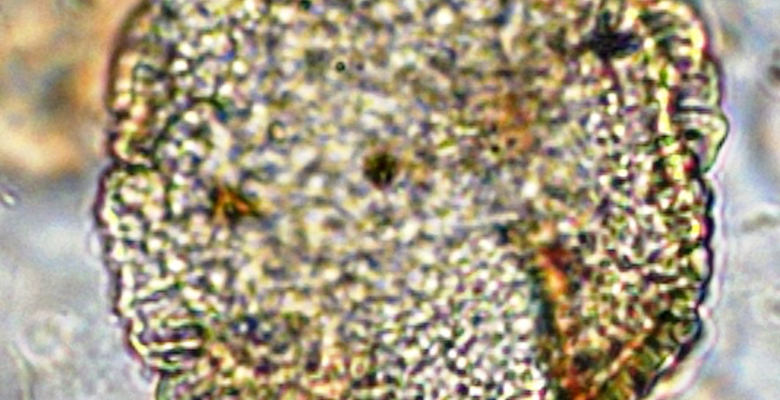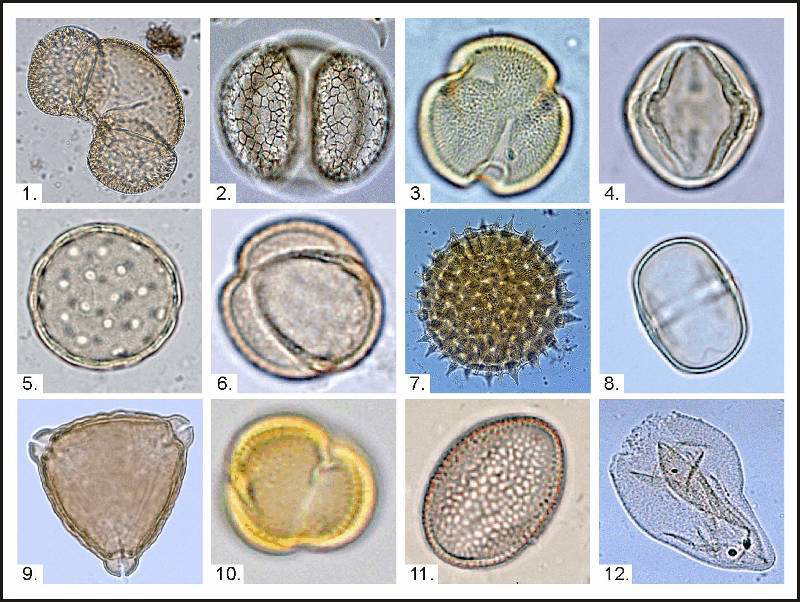
The older the layers examined by scientists the smaller is the probability of finding anything but stone objects there. Very seldom scientists find wood, leather, tissue of human remains during excavation work. Special conditions are required for preserving such objects – dry and cold climate, low temperature fluctuations and neutral soil composition. Pollen and spores offer to archeologists, geologists, geographers and anthropologists a great deal of information about the surrounding landscape, the nature of the local vegetation and climate in specific periods.
The most interesting results are obtained when data from various fields of science compliments each other. For example, the type of food procurement is directly linked to the natural landscape. Scientists from the Institute for Archeology and Ethnography of the Siberian Chapter of the RAS have discovered that the beginning of husbandry among the ancient people in the Barabinsk Lowlands (5-7 thousand years ago) coincided with the rise of temperature when the coniferous forests began to disappear and the lowlands turned into full-scale pastures. That data is confirmed by the discovery of horse, goat and sheep bones dating back to the same period.

Archive from a lake bottom
The term palynology is based on the Latin word pulvis meaning dust. Palynological records are one of the most reliable and trustworthy archives for the research of nature of the past. The size of the pollen grains is in the range between 7-10 to 250 microns (usually only 20-60 micrometers). Pollen of all grassy and woody plants has a very robust bio-polymeric shell that is preserved for many thousands of years. It is similar to the chitin shell in insects only more robust. Plants produce a lot of pollen, thus, researchers successfully use statistical approach. Each soil sample contains no less than 300 pollen grains. Sometimes, after washing, centrifuging and multiple treatments with acids and alkalis several kilos of soil sample turn into a fraction of one gram of the material sought.
“Presence of the pollen of specific plants, its quantity and composition and combination with other plants’ pollen one can find out not only what plants used to grow on specific territory during a specific time period”, explains Natalia Rudaya, a biologist from the Institute for Archeology and Ethnography of the Siberian Chapter of the RAS. “Such data tells researchers about the average summer temperature, humidity and soil composition. This explains what kind of habitat for humans and animals a specific territory offered. A bunch of pollen grains help accumulate and expand information and restore the picture of the nature in the past millenniums.
Obtained information can be verified and confirmed by the results of archeological excavations – by finding bones of animals, birds and fish. One cannot correlate such processes: archeology and palynology both rely on facts, which either correspond to each other or not.
“While studying the Barabinsk wooded steppe we used the pollen from the lake bottom residue – the richest top-quality source of information”, says Snezhana Zhilich of the Institute for Archeology and Ethnography of the Siberian Chapter of the RAS of her work on the grant from the Russian Science Foundation. “The most ancient lakes contain information about their region accumulated over millions of years. The bottom layers of the residue in the Lake Bolshiye Toroki in Kargatsky area of Novosibirsk Region date back about 8 thousand years.
According to Natalia Rudaya, it makes no sense to take pollen and spore samples from Paleolithic findings as nothing sticks to stone. She explains that pollen samples are taken directly from deep soil layers from a vertical section. The best way to collect pollen is from bore specimen from lake bottom. Lakes are ideal archives for pollen. It is well preserved in airless medium and can be successfully dated as the layers build up in sequence. Recently researchers from the Institute for Archeology and Ethnography analyzed a bore specimen from the Teletskoye Lake dating back up to 4 thousand years. A pipe several meters long carefully collects core specimen. In Lake Baikal the height of the core sample is 600 meters. Besides pollen and spores small particles of coal and parasite cysts descend to the lake bottom. Based on the layers of coal fractions one can precisely date the periods of great fires. Parasite cysts, specifically those of the whipworm (a large parasite that lives in the large intestine of humans) have been discovered in cave layers of the Neolithic period. In Paleolithic era layers scientists discovered no whipworm cysts.
Where does the cave pollen come from?
Natalia Rudaya explains that by examining the pollen and spores from ancient burial places one can find out what ancient animals and people ate. Mummies and animal and human skeletons often bear the pollen of cultivated and wild plants. In 1991 in Tyrolean Alps at the altitude of 3210 m mountain climbers found a frozen body of a Neolithic man, who, according to scientists, lived about 5200 years ago. Based on the pollen composition on his clothing the researchers could find out that during his last day he had made a long trip by descending from subalpine zone into the valley and then went back up into the mountains. Nine to twelve hours prior to his death he walked through a deciduous forest, then ascended to coniferous forest, where he ate his last meal, then went up to the mountain pass where he died. Researchers discovered pollen grains of wheat, pigweed, primrose, cowslip and Bracken fern, which appear to have been a part of his diet as the samples contained lots of them. Scientists also found particles of coniferous wood, which can signal that food was prepared on open fire. The pollen of einkorn can possibly mean the existence of primitive agriculture.
Researchers from all over the world posed many questions regarding the pollen that covered the grave of the Neanderthal found in the Shanidar Cave in the early 1970s. The burial dated back 60 thousand years. Flower pollen in such quantity could not appear inside the cave on its own as flower pollen doesn’t have the same high volatility as the pine tree pollen, for example. Consequently, the body of the deceased could be covered in flowers. This could in its turn mean that the modern burial ritual dates back to the Neanderthal times. But samples taken from the cave revealed that they still contained pollen, the modern kind. The bees, cave visitors or animals, or even the wind could have brought it in. The pollen discovered was not only from composite plants, but also from many other plants that grew around the cave. Thus, the version of flower bunches brought to the cave remains the most reliable one. Natalia Rudaya points out modern composite plants’ pollen has also been discovered in the Chagyr Cave in the Altai Region, despite that fact that samples taken from the area around the cave did not contain so much pollen. Who brings the pollen to the cave then? The bees? Turbulent air flows? Scientists still have to solve this problem.
Lots of ancient micro evidence
Sometimes pollen serves as the only witness of some historic event. For example, traces of agricultural activity as pollen of cultivated cultures can be discovered while no corresponding tools have been preserved, even in archeologically “clean” layers (with nothing discovered) – for example, in moors, lake or floodplain deposits. Recent publication by an international group of palynologists and paleo-botanists revealed that agriculture appeared in Western Siberia in late II – early I millennium BC.
Another archeological mystery that was solved by palynological research was linked to the famous Chinese Terracotta Army buried in the Qin Shi Huang’s mausoleum in 210-209 B.C. When the excavations began in 1974 the researchers could not determine the place where the terracotta statues of warriors and horses had been made as furnaces where the figures could have been baked had not been found. The study of the pollen stored in the cracks of the thick layer of the terracotta figures and the soil samples inside the mausoleum yielded the answer to that question.
It turned out that the pollen present could be clearly divided into two groups: one type was encountered in the figures of the warriors, the other type – in the horse figures. The comparison of the two pollen groups revealed that the warriors and the horses were produced in different places.
But palynologists cooperate not only with archeologists, but also with geologists, biologists and geographers. Thanks to palynology research it became known that deciduous trees that grew in Western Siberia dozens of thousands years ago completely disappeared from that territory after the Ice Age. One cannot find hazel, oak, linden or hornbeam in Siberian forests. However, planted linden trees take root and grow well, which means that local climate and soil are good for linden. But no natural linden population has appeared yet.
Steppe tundra all around
Based on the pollen residue in ancient deposits scientists discovered that during Pleistocene when mammoths, buffalo and woolly rhinoceroses were wandering around the planet, the type of landscape called steppe tundra was widespread along the vast territories of Eurasia and North America. Relict fragments of steppe tundra can still be found in Khakassiya and Sayany-Altay. It was a territory with a dry and cold climate covered with steppe grass (primarily cereals) as opposed to moss. All the mega fauna mentioned above ate that grass throughout the short summers and long snowless winters as after a dry autumn the thick grass turned into rich source of hay. Later on when the climate became warmer and more humid and the ice cover moved up north, the rich pastures were overgrown with bushes and later by coniferous forest becoming completely unsuitable for the mega fauna. In our days tundra (reindeer) and steppe (saigas) animals as well as insects and plants are spread over various territories.
The climate drives almost all processes on our planet. And the pollen analysis helps reconstruct climate change over many millenniums and even forecast its change in the future.
Maria Rogovaya







